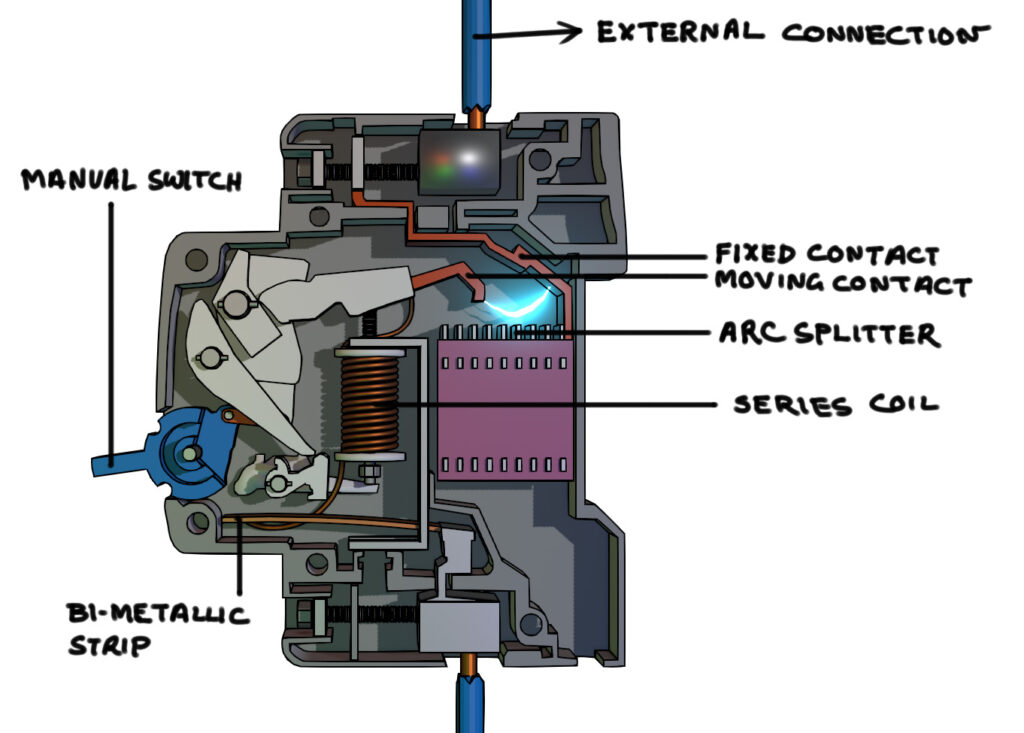A miniature circuit breaker, or MCB, is an essential protective device in low-voltage electrical systems because it protects the circuit from both overload and short-circuit faults. Let us explore the constructional details and the working of an MCB.
Introduction to MCB
An MCB has two main functions. We can use it as a toggle switch to switch the circuit on and off. It also has an inherent ability to trip the circuit during a short-circuit fault or an overload condition. In both cases, the MCB automatically trips the circuit to prevent damage.
- A short circuit fault
- An overloading condition
In both cases, the miniature circuit breaker trips the circuit to prevent damage.
Construction of MCB
The main construction of the MCB consists of:
- Trip Coil – We connect the trip coil in series with the main circuit. It carries the entire load current during normal, overload, and fault conditions. Therefore, it provides protection during short-circuit faults.
- Bimetallic Strip – We connect a bimetallic strip in series with the main circuit. It carries the entire load current, and it protects the circuit during overload conditions.
Other important constructional parts of a miniature circuit breaker are:
- Contact Assembly – Includes fixed and moving contacts. The movement or rotation of the moving contact makes or breaks the circuit during both manual operation and automatic fault operation.
- Manual Switch – There is a manual switch in the MCB. We use this switch to switch the breaker on and off manually.
- Spring-Loaded Lever – This mechanism releases during overload or fault conditions to separate the contacts. Also, during manual operation, this mechanism rotates.
- Arc Splitter – When an arc forms, the splitter divides it into many segments. This arrangement efficiently extinguishes the arc when the contacts separate.

Working of MCB
After discussing the constructional details, let us now discuss the working principle of the MCB under different operating conditions. These are:
- Normal Operation – When we switch on the circuit, current flows through the fixed contact, then the moving contact, then the coil, and after that through the bimetallic strip. Finally, the current leaves from the neutral terminal. When we manually switch off the MCB by pulling down the lever, the moving contact rotates and detaches from the fixed contact, thereby opening the circuit.
- Short-Circuit Condition (Magnetic Trip) – When a short circuit occurs, the current increases sharply. During normal operation, the coil produces a magnetic field, but it is not strong enough to move the plunger. During a short circuit, the high current increases the magnetic field strength beyond the threshold. This moves the plunger, which strikes the tripping lever. As a result, it releases the spring-loaded lever. Then the movement of the lever separates the moving contact from the fixed contact instantly, breaking the circuit. We refer to this action as magnetic tripping of the MCB.
- Overload Protection (Thermal Trip) – When excess current flows through the circuit, it also passes through the bimetallic strip. The strip heats up and bends. This bending action releases the spring-loaded lever, which separates the moving contact from the fixed contact, breaking the circuit. This prevents damage from prolonged overload conditions.
Arc Extinction
Whenever contacts open, an arc forms. Due to the horn-shaped contacts, the arc moves towards the arc splitters. The splitters divide the arc into smaller segments, increasing its resistance and length. Finally, the arc extinguishes by itself. This ensures smooth and safe interruption of the current.
Series Trip Mechanism of MCB
In this mechanism, the trip coil is connected in series with the main circuit. That is why it is called the Series Trip Mechanism.
Advantages of Series Trip Mechanism
- The coil uses the main circuit power, so the chances of failure are less.
- Unlike a shunt-trip coil, it does not need external power or a current transformer to operate.
- This makes the MCB compact as the trip coil is placed inside the breaker.
Limitations
- The mechanism is not stable for high-voltage or high-rated breakers.
- In high-voltage or high-rated breakers, the current is very high, requiring a large trip coil.
- Accommodating a large coil inside the breaker makes it bulky and uneconomical.
- Therefore, the series trip mechanism is used only in low-voltage breakers.
Conclusion
The construction of MCB and the working of MCB highlight how effectively it protects electrical circuits. Using both thermal tripping and magnetic tripping ensures safety against overloads and short circuits.
In simple words, an MCB or miniature circuit breaker is a reliable safeguard in any electrical installation.
